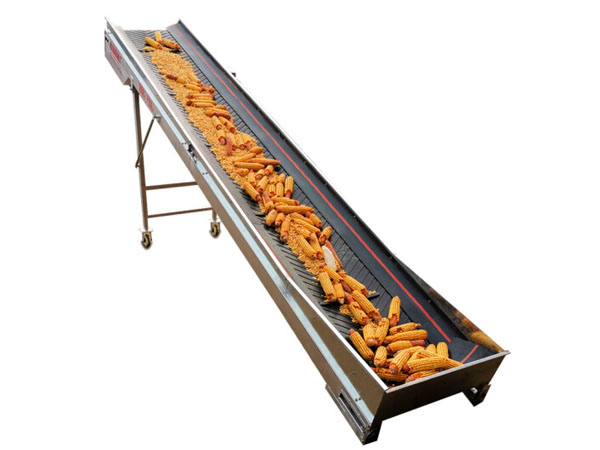Grain belt conveyor
What is Grain belt conveyor?
Grain belt conveyors are primarily used for long-distance, large-volume, continuous conveying of grain. Depending on application requirements, grain belt conveyors can be categorized into various types, such as sidewall belt conveyors, incline belt conveyors, and tubular belt conveyors, to accommodate varying conveying angles, material properties, and environmental conditions. They are typically designed to handle tens to hundreds of tons of material per hour and can convey grain over distances of hundreds of meters or even longer, meeting the practical needs of diverse operations. Adjusting the conveyor belt width and operating speed allows for flexible configuration of grain handling capacity.

What are the types of grain belt conveyors?
Depending on the application and conveying requirements, grain belt conveyors are primarily categorized into three types: sidewall belt conveyors, incline belt conveyors, and tubular belt conveyors. Each type has unique structural designs and technical parameters to accommodate varying conveying angles and material properties.
Sidewall Belt Conveyors
Sidewall belt conveyors, also known as high-angle belt conveyors, are equipment capable of conveying at large angles. They feature a conveyor belt with corrugated sidewalls and partitions. Corrugated sidewalls, located on both sides of the conveyor belt, prevent material from spilling over the edges. They are flexible enough to adapt to the curvature of the conveyor belt. Crossbars, fixed transversely to the conveyor belt, divide the material into smaller compartments, effectively preventing it from sliding down during conveying at steep angles. Regarding load-carrying methods, the conveyor belt can convey materials horizontally, inclined, or even vertically, and can easily change conveying direction, such as transitioning from horizontal to inclined.
Maximum conveying angle: Due to the sidewalls and crossbars, the maximum conveying angle can reach 90 degrees, far exceeding that of ordinary belt conveyors.
Capacity: Depending on the width and speed of the conveyor belt, the conveying capacity can range from tens to thousands of tons per hour.
Conveying speed: Typically ranges from 1.5 to 3.5 meters per second, depending on the nature of the conveyed material and the required conveying speed.
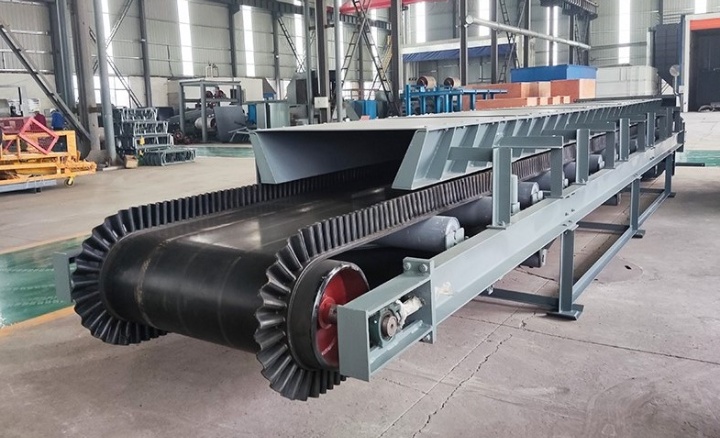
Incline belt conveyors
Incline belt conveyors are similar to ordinary belt conveyors, but are primarily used to convey materials at shallow angles. The conveyor belt can be flat or have patterned or V-shaped ribs to increase friction between the material and the belt, preventing it from sliding. Its structure is relatively simple, typically consisting of a frame, drive unit, conveyor belt, and rollers.
Maximum conveyor inclination angle: Generally between 15 and 20 degrees. Using a patterned or V-belt, the angle can be slightly increased. However, excessive inclination can still cause material to slide.
Conveying speed: Typically between 0.8 and 2.5 m/s, adjusted based on the inclination angle and material characteristics.
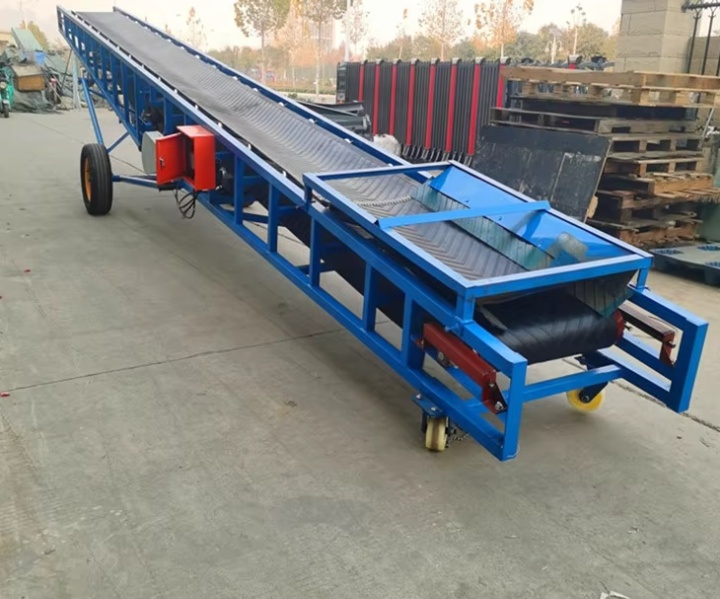
Tubular Belt Conveyor
Tubular belt conveyors, when in operation, wind the conveyor belt into a tubular structure, completely enveloping the material for conveying. The conveyor belt, passing through a special roller assembly, gradually winds from a flat surface into a circular tube. The material is conveyed within this "tube," effectively preventing dust and spillage. It is particularly suitable for conveying powdered or granular materials. The conveyor belt unwinds again on its return, passing through a series of rollers and returning to its starting point. This structure also enables bidirectional conveying and can accommodate complex conveying paths, such as curves and turns.
Maximum conveying angle: Typically between 20 and 30 degrees, depending on the material properties and pipe diameter.
Conveying capacity: The conveying capacity depends on the pipe diameter and conveying speed, and can reach large throughputs ranging from tens to thousands of tons per hour.
Conveying speed: Typically between 2.5 and 5.0 meters per second, it is a relatively high-speed conveying method.

What are the advantages of grain belt conveyors?
Grain belt conveyors offer a range of outstanding advantages. From their high-volume conveying capacity, gentle grain handling, and flexibility to adapt to complex environments, these features make them a key piece of equipment connecting the grain supply chain.
High conveying efficiency: Grain belt conveyors enable continuous, large-volume conveying of grain. Because the conveyor belt width and speed can be adjusted as needed, their conveying capacity can reach hundreds or even thousands of tons per hour, significantly improving the efficiency of grain handling and transfer.
Long conveying distances and strong adaptability: Grain belt conveyors can easily transport grain over long distances and can be flexibly arranged to suit site terrain, such as horizontal, inclined, or climbing. In particular, some special conveyor types (such as sidewall belt conveyors) can transport grain at large angles or even vertically, effectively utilizing space.
Minimal damage to grain: Compared to some mechanical conveying equipment (such as screw conveyors), belt conveyors provide a smoother conveying process, without squeezing, rubbing, or impacting the grain. Therefore, they maximize grain integrity and minimize breakage, making them particularly suitable for conveying materials with high integrity requirements, such as seeds and malt.
Simple maintenance and low operating costs: Belt conveyors have a relatively simple structure, primarily consisting of a conveyor belt, rollers, and a drive unit. This reduces daily maintenance and makes inspection and replacement of wearing parts easy.
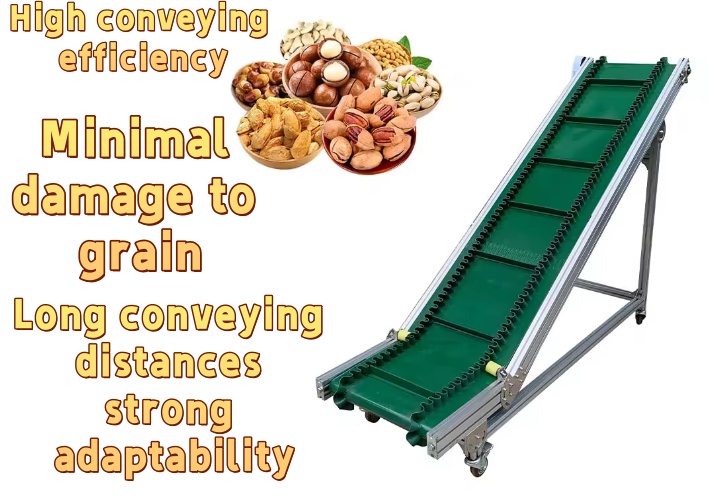
Grain belt conveyor parameters
|
Belt width (mm) |
Conveying length(m) Power(kw) |
Conveying speed (m/s) |
Conveying amount (t/h) |
||
| B400 | ≤10 | 12-15 | 5-30 | 1.25-2.0 | 30-60 |
| 3 | 3-4 | 4-7.5 | |||
| B500 | ≤10 | 12-15 | 15-30 | 1.25-2.0 | 40-80 |
| 3 | 4-5.5 | 5.5-7.5 | |||
| B650 | ≤10 | 12-15 | 15-30 | 1.25-2.0 | 80-120 |
| 4 | 7.5 | 7.5-11 | |||
| B800 | ≤10 | 12-15 | 15-30 | 1.25-2.0 | 120-200 |
| 4 | 7.5 | 7.5-15 | |||
| B1000 | ≤10 | 10-20 | 20-40 | 1.25-2.0 | 200-320 |
| 5.5 | 7.5-11 | 11-22 | |||
| B1200 | ≤10 | 10-20 | 20-40 | 1.25-2.0 | 290-480 |
| 7.5 | 7.5-15 | 15-30 | |||
| B1400 | ≤10 | 10-20 | <20-40 | 1.25-2.0 | 400-680 |
| 11 | 15-22 | 22-45 | |||
| B1600 | ≤10 | 10-20 | <20-50 | 1.25-2.0 | 600-1080 |
| 15 | 22-30 | 30-75 | |||
| B1800 | ≤10 | 10-20 | <20-50 | 1.0-2.0 | 200-1500 |
| 18.5 | 30-45 | 45-110 | |||
| B2000 | ≤10 | 10-20 | <20-40 | 1.0-2.0 | 1000-2000 |
| 22 | 45-55 | 55-132 | |||
| B2400 | ≤10 | 10-20 | <20-40 | 1.0-2.0 | 1500-3000 |
| 30 | 55-75 | 75-185 | |||
What are the applications of grain belt conveyors?
Grain belt conveyors, due to their flexibility and minimal damage to materials, are widely used in grain loading, unloading, storage, processing, and production, becoming a key link in the entire grain supply chain. The following are their main application scenarios:
Material loading, unloading, and transfer: Grain belt conveyors are commonly used to transfer grain from one mode of transport (such as trucks, trains, or ships) to another, or from a transport mode to a storage facility.
Transportation within storage facilities: Within grain storage facilities (such as silos and warehouses), belt conveyors are used to transport grain from the unloading area to a designated storage location or to transfer grain between different storage units. Their smooth conveying process reduces grain breakage and ensures material quality.
Connecting processing and production lines: In grain processing, belt conveyors are key equipment connecting different processes. They can transport grain from washing equipment to the mill, or from the mill to mixing, packaging, and other production lines. This automated conveying method improves production efficiency and ensures the continuity of the production process.
Adapting to complex terrain and spatial layouts: Depending on the specific application requirements, belt conveyors can be designed in various configurations to adapt to different terrains and spatial layouts. For example, where changes in conveying direction or significant height increases are required, belt conveyors with turning capabilities or high-angle belt conveyors can be used to achieve flexible material transport.
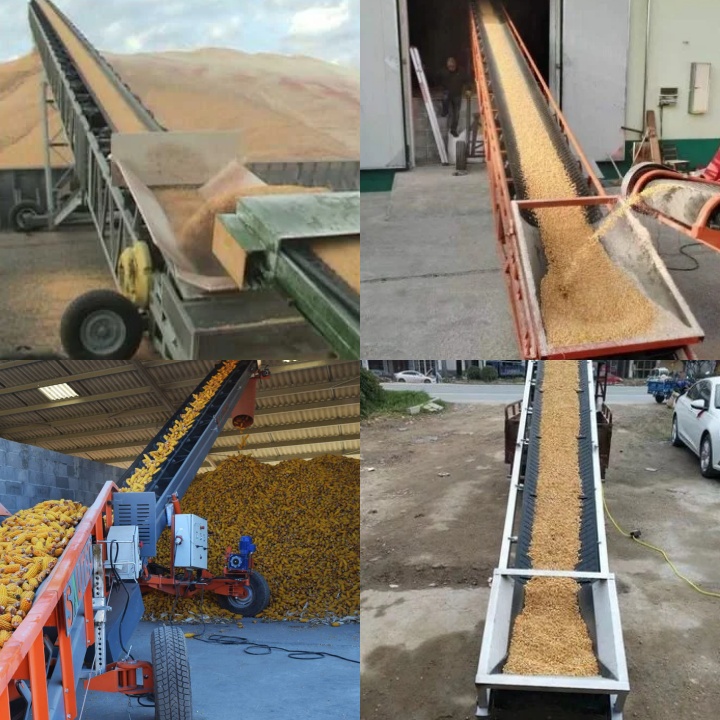
Grain belt conveyors, with their exceptional conveying distance, handling capacity, and adaptability to material characteristics, have become an indispensable component of grain handling processes. Whether used for loading and unloading grain, transferring grain within silos, or connecting different stages of a processing line, this type of equipment demonstrates its applicability in a variety of scenarios. Its structural design makes daily maintenance relatively simple, and its operation meets the fundamental requirements of today's material handling.
